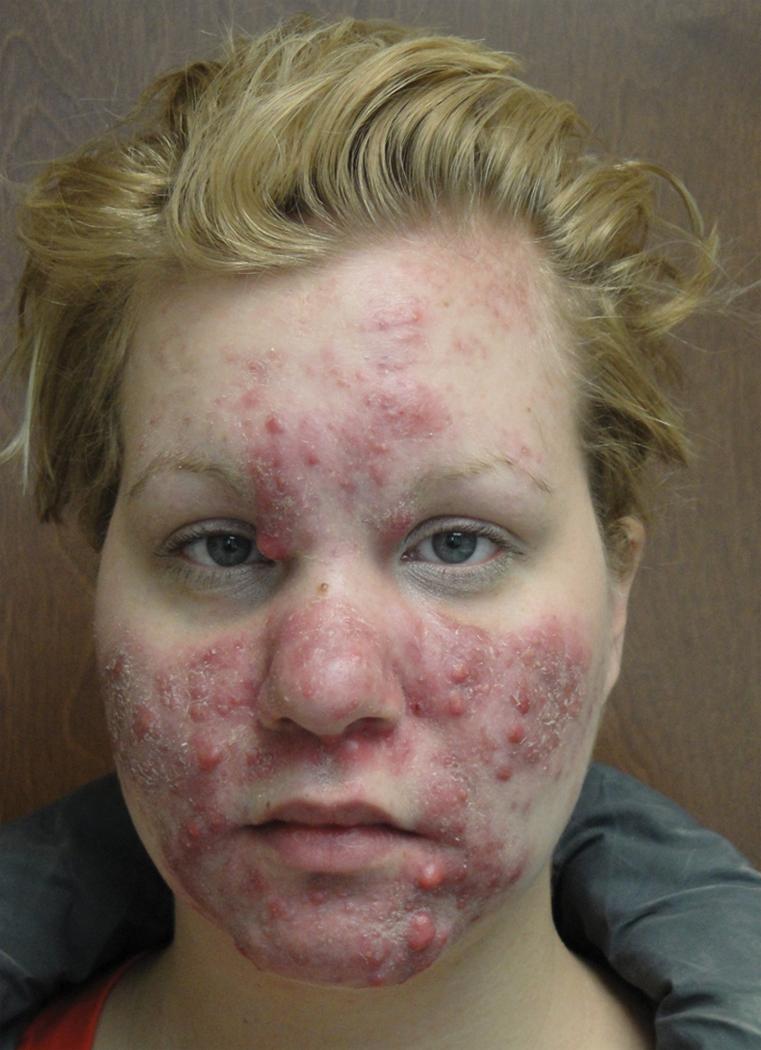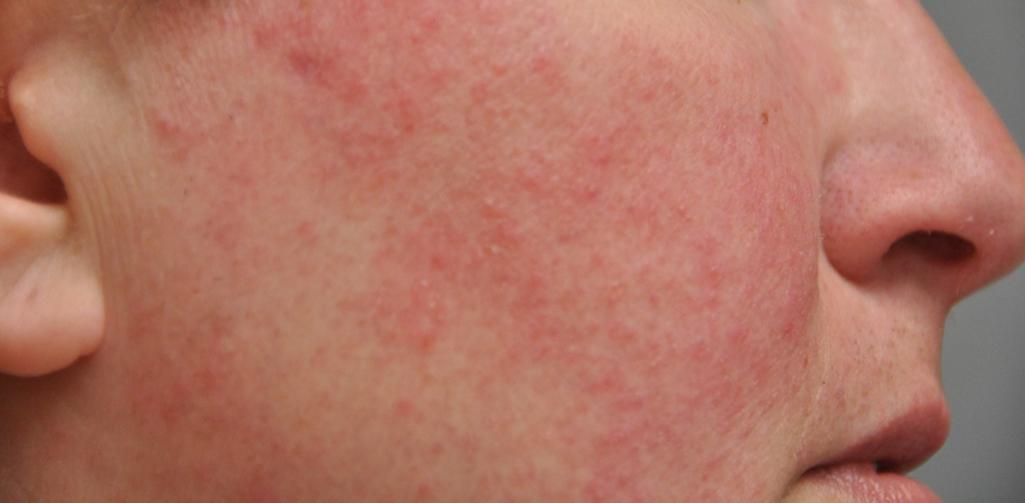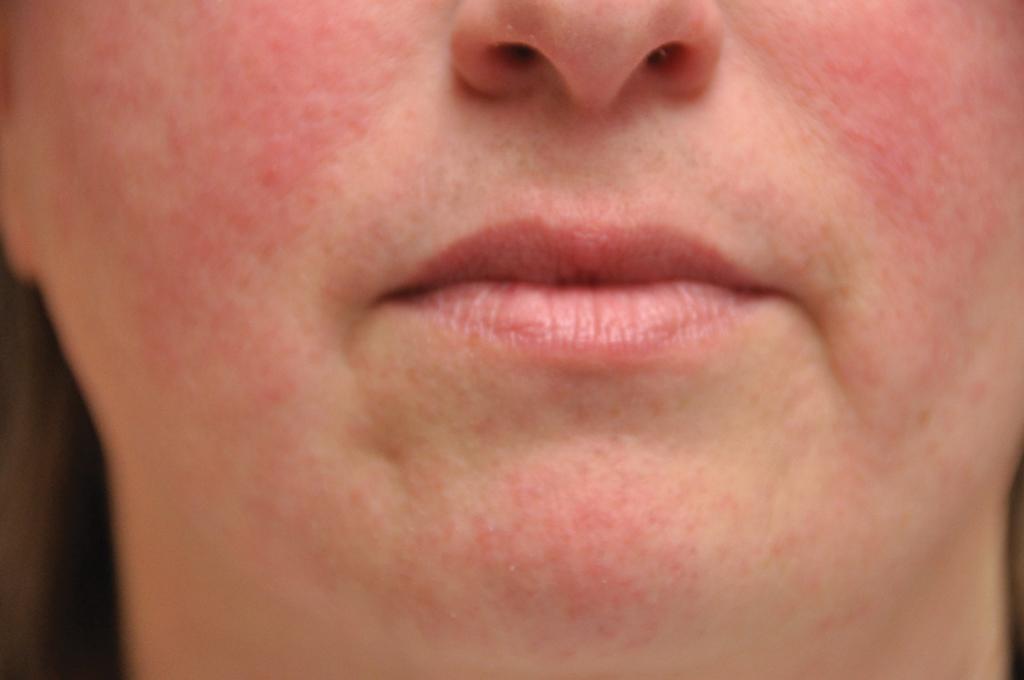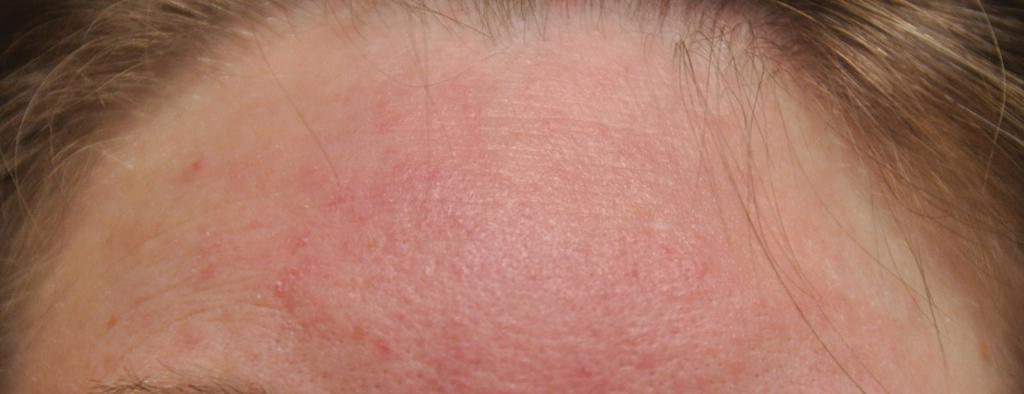Physical Address
304 North Cardinal St.
Dorchester Center, MA 02124
Payal Shah and Nikita Lakdawala
Acne is most commonly located on the face, neck, back, upper chest, and upper arms where pilosebaceous units are most densely concentrated.
Acne most commonly affects adolescents.
Adult women have a predisposition to a jawline distribution of papules.
Acne in men commonly involves the trunk.
Morphology ranges from comedones (i.e., clogged open and closed pores that create whiteheads/blackheads) to papules, pustules, cysts, and nodules. Inflammatory lesions can result in permanent scarring.
Family history is often positive.
All races are equally affected.
Severe acne can result in disfiguring scarring ( Fig. 9.1 ).

The etiology of acne is complex and involves sebaceous gland hypersensitivity and the subsequent inflammatory response to circulating androgens, P acnes, and genetics. Some medications (such as lithium, steroids, and anticonvulsants) can precipitate acne, as can some endocrine disorders, such as polycystic ovarian disease. Finally, occlusive makeup and athletic gear can cause acne to worsen.
The main differential includes perioral dermatitis and rosacea.
A perioral predilection of inflammatory lesions is more consistent with perioral dermatitis.
The presence of comedones helps differentiate acne from both rosacea and perioral dermatitis.
The patient’s skincare routine should be reviewed because frequent rubbing, touching, and overcleansing of the face is known to exacerbate acne. Additionally, cosmetics and oil-based hair products can also exacerbate acne.
Lifestyle contributions of grease/oils should be reviewed. Skin occlusion from occlusive make-up, sporting equipment, tight clothing, or backpacks may exacerbate acne.
The patient’s medication list should be reviewed for the possibility of drug-induced acneiform eruption. The sudden onset of monomorphic, inflammatory papules should raise suspicion of a drug-induced acneiform eruption. Triggering agents include, but are not limited to, systemic corticosteroids; topical corticosteroids; anabolic steroids; danazol; stanozolol; testosterone; lithium; isoniazid; phenytoin; cyclosporine; medroxyprogesterone; low-estrogen oral contraceptives; progesterone-only birth control; and vitamins B2, B6, and B12.
Menstrual and medical history should be examined in females to consider hormonal acne, particularly in the setting of other signs of hirsutism. Endocrine disorders can cause hyperandrogenism that can predispose individuals to acne development. In these circumstances, checking the free and total testosterone, sex-hormone binding globulin, follicle-stimulating hormone, luteinizing hormone, and dehydroepiandrosterone is beneficial. Any hormonal imbalance is important to recognize because it guides treatment.
Acne is usually a clinical diagnosis; routine histologic confirmation is not indicated.
In the setting of small, itchy monomorphic follicular pustules on the upper back, shoulders, and scalp of an adolescents or young adult, scraping a pustule with potassium hydroxide (KOH) testing can assess for a diagnosis of Pityrosporum folliculitis .
A healthy skincare routine should be established that includes twice daily facial washing with a gentle cleanser. Cosmetic products that are used should be noncomedogenic and/or oil-free.
An assessment of the severity of the acne guides the treatment.
Mild acne should be treated with benzoyl peroxide, a topical retinoid, or a topical combination therapy with benzoyl peroxide and either a topical antibiotic, a topical retinoid, or both.
Moderate acne should be treated with topical combination therapy or consideration of an oral antibiotic with adjunctive use of a topical retinoid, benzoyl peroxide, or both.
Severe acne should be treated with oral antibiotics and a combination topical therapy or oral isotretinoin; referral to dermatology to prevent progression of permanent scarring is recommended.
Patients with cystic acne and substantial pre-existing scarring should consider isotretinoin therapy.
Topical antibiotic use is best used in combination with benzoyl peroxide to minimize antibiotic resistance.
Topical retinoids should not be used at the exact time as benzoyl peroxide because the former may oxidize and be inactivated.
Management strategies to consider if the desired response is not achieved include a change of topical retinoid, change to topical dapsone use, increase of the oral antibiotic dose, change to an oral antibiotic choice, use of oral contraceptives, use of spironolactone, and/or referral to a dermatologist.
Noncompliance with therapies may lead to worsening of acne and the potential for scarring.
In cases refractory to traditional antimicrobial therapy, skin and nasal swabs can be considered to exclude gram-negative folliculitis.
For mild to moderate acne, the recommended initial regimen includes the use of 2.5% to 5% benzoyl peroxide, a daily face wash, and the gradually increased use of topical retinoids to daily at bedtime (tretinoin 0.025%–0.1%, tazarotene 0.05%–0.1% cream or gel, or adapalene gel 0.1%–0.3%).
Retinoids are contraindicated in pregnancy.
Topical antibiotics, such as clindamycin 1% lotion or solution, erythromycin 2% gel, dapsone 5% or 7.5% gel, or minocycline 4% foam, can also be used for mild to moderate cases.
Topical antibiotics should be combined with a benzoyl peroxide wash or gel if possible to decrease antibiotic resistance.
Adverse effects of topical therapies are common and expected. These include dryness, pruritis, peeling, burning, redness, and stinging. Daily oil-free moisturizer use can help handle these symptoms and maintain the skin barrier that is weakened by acne disease.
If there is a partial but inadequate response after a 3-month trial of combination topical therapies, oral antibiotics can be tried for 3 to 4 months (doxycycline 100 mg daily or BID; minocycline 100 mg daily or BID; tetracycline 500 mg daily or BID).
Tetracycline antibiotics are contraindicated in pregnancy.
Known adverse effects of oral antibiotics include gastrointestinal (GI) upset, photosensitivity, and dizziness.
Hormonal therapy can also be tried for female patients, particularly if the acne is in a perioral and jawline distribution (spironolactone 50–100 mg daily or BID).
If the response continues to be inadequate and you are confident that the patient has acne that is refractory to a combination of topical therapies and oral antibiotics, then the next step includes isotretinoin therapy.
Registering isotretinoin use with the iPLEDGE program is required. Healthcare providers must be registered with iPLEDGE before they can prescribe isotretinoin and each individual patient must be registered.
Isotretinoin initiation requires obtaining baseline and regular interval levels of the complete blood count (CBC), glucose test, liver function test, fasting lipids, and pregnancy tests for female patients (because isotretinoin is known to be teratogenic).
Females should be on dual-contraception use during the course of treatment.
Patients start typically with 0.5 mg/kg daily, which increases to 1 mg/kg daily after 1 month.
Treatment duration of isotretinoin is typically 5 to 6 months, but the medication should be continued at least 2 months after total clearance of acne to increase the chance of a durable response.
Most healthcare providers use weight-based isotretinoin goals (150 mg/kg to 220 mg/kg).
Known adverse effects include xerosis, cheilitis, elevated liver enzymes, and hypertriglyceridemia.
Although acne is a benign skin condition, it can lead to permanent scarring or postinflammatory hyperpigmentation and significant psychological distress, making early treatment intervention critical for optimal patient outcomes.
Acne requires consistent treatment adherence for months to achieve the clinical response. Therefore lack of response before 6 to 8 weeks of treatment should not be assessed as refractory acne or a failure of treatment.
Your doctor has diagnosed you with acne, a very common chronic inflammatory condition of the pilosebaceous unit that presents because of a combination of factors, including increased sebum production, follicular hyperkeratinization, proliferation of bacteria ( Cutibacterium acnes ), and inflammation. It often is a self-limited disease that typically begins in adolescence because of androgen-stimulated sebum production and keratinization changes of the follicle.
Acne should be treated because it can cause permanent scarring of your skin. Acne treatment is targeted at preventing new lesions rather than treating existing lesions. The importance of treatment adherence cannot be overstressed because a clinical response is only expected after at least 8 weeks and ideally up to 2 to 3 months of strong adherence. Lack of adherence is the biggest reason for treatment failure. Treat the entire field of potential acne, rather than individual spots, with topical therapies.
The use of harsh cleansers and antibacterial soaps is discouraged because they may exacerbate acne. Additionally, pimples should not be squeezed because it may lead to scarring and infection.
Low glycemic diets that minimize the spike in blood sugar and insulin levels may improve acne, but more studies are needed to establish the relationship. Diets that are considered low glycemic can be found on the Internet.
Payal Shah and Nikita Lakdawala
Facial distribution most often involves the nose, cheeks ( Fig. 9.2 ), brow ( Fig. 9.3 ), and chin ( Fig. 9.4 ), usually with sparing of the nasolabial folds.



Rosacea tends to predominate in individuals with lighter skin types.
Episodic flushing with a sensation of stinging/burning is common.
Episodes may be triggered by hot beverages, spicy foods, alcohol, chocolate, stress, extreme temperatures changes, and contact with Demodex spp.
Facial edema is possible with sparing of the periocular areas.
The morphology is a background erythema with telangiectasias, pustules, and papules.
By definition, rosacea lacks comedones.
Severe disease may result in phymatous changes (i.e., a thickened, cobblestone appearance commonly on the nose) and enlarged pores in the skin.
When ocular involvement occurs, patients may present with conjunctivitis and chalazia.
The etiology of rosacea is complex and not completely understood. Nevertheless, it is multifactorial and likely involves vascular abnormalities, environmental triggers, microorganisms (such as D. folliculorum and H. pylori ), and changes in the dermal matrix.
The main differential includes acne and seborrheic dermatitis.
The presence of comedones in acne helps differentiate it from rosacea.
Additionally, unlike acne, rosacea is unrelated to hormones.
Seborrheic dermatitis has scale, a greasy quality, and typically involves other areas like the retroauricular area and scalp that may help differentiate it from rosacea.
A review of the ocular symptoms, including dryness, itching, redness, and grittiness, should be performed to assess for ocular rosacea involvement.
The patient should be asked about triggers and advised to avoid triggers to assess for improvement in symptoms.
Because rosacea is a clinical diagnosis, routine histologic confirmation is not indicated.
If the patient presents with flushing, rule out other serious conditions that can cause flushing (such as ordering urinary 5-hyroxyindoleacetic acid levels for possible carcinoid syndrome).
Facial erythema in a malar distribution with other signs of lupus, such as photosensitivity, may warrant ordering the appropriate serologies.
Monomorphic papules and pustules may suggest a drug-induced rosacea eruption and warrant a review of the medication history.
An assessment of the predominant phenotype and severity guides treatment.
Severe rosacea can be treated with oral and topical therapy with considered referral to an ophthalmologist if ocular involvement is suspected.
Papulopustular rosacea is more effectively treated by topical therapies than the erythematotelangiectatic type.
Topical therapies include 0.75% metronidazole, ivermectin 1% cream, 15% azelaic acid gel, and sodium sulfacetamide with 5% sulfur.
Brimonidine 0.33% gel may improve rosacea erythema but may also cause rebound erythema.
Alternative topicals include erythromycin or clindamycin lotion, calcineurin inhibitor, or permethrin 5% cream.
Flushing may be treated with clonidine 0.05 mg BID, beta-blockers, or laser/light therapy.
Rhinophymatous changes may require surgical or laser procedure for treatment.
Do not treat rosacea with topical steroids. It will improve the rash initially but ultimately make it worse.
The recommended initial regimen for rosacea includes 0.75% metronidazole gel BID for oily skin types and cream or lotion BID for normal/dry skin types. For all skin types, avoidance of triggers and the use of sun protection is recommended.
If there is a partial but inadequate response after a 3-month trial of combination topical therapies, oral antibiotics can be tried for 12 weeks (doxycycline 40mg daily; minocycline 50mg BID).
Tetracycline antibiotics are contraindicated in pregnancy.
Known adverse effects of oral antibiotics include GI upset, photosensitivity, and dizziness.
Alternative systemic therapies include oral metronidazole 200mg BID and azithromycin 250 to 500 mg TID.
If the response continues to be inadequate, severe papulopustular rosacea may be treated with systemic isotretinoin therapy, which requires obtaining a baseline and then regular interval levels of CBC, glucose test, liver function test, fasting lipids, and pregnancy tests for female patients (because isotretinoin is known to be teratogenic).
Registration of isotretinoin use with the iPLEDGE program is required.
Females should be on dual-contraception use during treatment course.
Patients start typically with 0.5 mg/kg daily, which increases to 1 mg/kg daily after 1 month.
The treatment duration of isotretinoin is 5 to 6 months.
Known adverse effects include xerosis, cheilitis, elevated liver enzymes, and hypertriglyceridemia.
Although rosacea is a benign skin condition, it can lead to significant psychological distress and possibly irreversible erythema and telangiectasias, making treatment intervention important for patients and their quality of life.
Your doctor has diagnosed you with rosacea, which is a common chronic inflammatory condition with a waxing and waning disease course that has no cure. The condition can be adequately controlled, however, with treatment adherence and lifestyle changes.
Your doctor will advise you to avoid hot beverages, spicy foods, alcohol, chocolate, topical steroids on this rash, stress, and extreme temperature changes because these may trigger your rash. Also, the use of broad-spectrum sunscreens and sun avoidance to help control the condition are recommended. Gentle skincare products and cosmetic camouflage may also help.
Your doctor will prescribe some topical therapies and possibly some antibiotics. It will take several weeks to months for your condition to improve. Please know that this eruption can recur in the future but can be treated again if that occurs.
Nikita Lakdawala
Perioral dermatitis is a benign, self-limited, inflammatory dermatosis.
The condition can cause some pruritus or burning or be asymptomatic.
Morphology of the lesions are acne like or rosacea-like and characterized by small, erythematous, papulopustular lesions. An eczema-like pattern with scale can also be seen.
Distribution is most commonly around the mouth, including the upper cutaneous lip and chin. The immediate vermilion border of the lip is spared. This can also affect periorificial sites, including the eyes and nose, which is termed “periorificial dermatitis.”
The demographic is variable, but the eruption commonly occurs in children. In the adult population, women between ages of 18 to 40 are mostly commonly affected
The main differential includes acne vulgaris, rosacea, allergic or irritant contact dermatitis, fungal infection, and impetigo.
Acne vulgaris and rosacea typically have a broader distribution on the face.
In allergic or irritant contact dermatitis, a history of the inciting agent and pruritus are commonly present. Additionally, the rash is usually confined to the area of the contactant.
In impetigo, yellow-tinged or golden-crusted erosions and/or vesicles can be visualized.
Fungal infection may be difficult to distinguish clinically; KOH preparation can aid in diagnosis.
The etiology of perioral dermatitis is unclear; the condition is frequently associated with topical or inhaled corticosteroid use.
Perioral dermatitis can resolve without treatment in several weeks to months or persist for several years.
A diagnosis of perioral dermatitis can typically be made using the history and the physical examination.
History should include timing, onset and duration of lesions, and symptomatology, including pain or pruritus secondary to eruption.
An inquiry into the topical skincare regimen should be undertaken because it is thought to contribute to development of the condition; other associations include fluorinated toothpaste and topical skincare products.
Reviewing the medication list is helpful because inhaled corticosteroids can be contributory.
A physical examination should include an examination of the morphology and distribution of lesions.
Skin swab culture may be beneficial to distinguish between perioral dermatitis and other infectious conditions.
In select rare cases where clinical diagnosis cannot be made, histologic confirmation with skin biopsy can be helpful.
Classification of severity of disease as mild, moderate, or severe can aid in management.
A gentle skincare regimen should be established in perioral dermatitis. This may include a gentle cleanser for the face.
Topical products, particularly cosmetics, should be minimized. Should a patient chose to use cosmetic products, she or he should use products labeled non-comedogenic and/or oil-free. Once a patient’s perioral dermatitis is under control, cosmetic products can be reintroduced, one at a time, to assess whether any individual cosmetic flares the perioral dermatitis.
When possible, topical corticosteroids should be discontinued; inhaled corticosteroids may be necessary for the patient’s other medical conditions.
The therapeutic approach depends on the severity of the disease.
Primary treatment options include topical antibiotics, topical calcineurin inhibitors, and oral antibiotics.
Topical therapy is preferred, with oral antibiotics limited to cases refractory to topical agents and moderate to severe cases.
Treatment options include erythromycin 2% gel; metronidazole 0.75% or 1% (cream, gel); clindamycin 1% (solution, lotion, gel); and pimecrolimus 1% cream.
Topical antibiotics, including erythromycin, metronidazole, and clindamycin, are typically less expensive and more readily available.
Topical pimecrolimus has also shown benefit. The U.S. Food and Drug Administration (FDA) has approved a so-called “black box” on the association of the topical medication and malignancy risk; the significance of the risk is thought to be minimal.
Twice-daily use of topical agents should be trialed for 4 weeks.
Topical antibiotics and azelaic acid may be continued for another 4 weeks of treatment if partial clearance is noted.
If no benefit is obtained from a topical regimen, it is preferred to trial an alternate agent before transitioning to oral therapy.
Oral therapy may be necessary in cases with more severe disease presentation, symptomatology, or emotional distress related to the condition.
Oral antibiotics options include erythromycin, tetracycline, doxycycline, and azithromycin.
Tetracycline-class antibiotics carry a risk for gastrointestinal distress; additionally, doxycycline is associated with photosensitivity.
In children 8 years of age and younger, erythromycin is a preferred approach because tetracycline antibiotics are contraindicated. Azithromycin may be also be considered as a second-line agent.
In adults, a few different options may be trialed.
Tetracycline 250 mg or 500 mg can be tried twice daily for 4 weeks.
Doxycycline 100 mg can be used twice daily for 4 weeks.
Erythromycin base 333 mg three times daily or 500 mg twice daily can be tried for 4 weeks.
If 4 weeks of therapy is insufficient, an additional 2 to 4 weeks of treatment may be of therapeutic benefit.
Perioral dermatitis is a benign, self-limited, inflammatory dermatosis. It can present with significant symptomatology and be a source of emotional distress. Patients often are upset by this eruption and therefore it should not be ignored. History and physical examination are essential because clinical diagnosis can be made in a majority of cases. Counseling is important in management. Avoidance of topical corticosteroids and the limiting of topical skin products is essential to therapy. Consistent topical or oral treatment for at least 4 weeks is often necessary for therapeutic benefit. Expectations regarding the timeline of improvement can be helpful. Also, the eruption may recur and patients should be warned about this possibility. The condition carries a good prognosis and resolves spontaneously in weeks to months. Therapy can be undertaken to aid resolution and alleviate symptoms associated with the condition.
Your doctor has diagnosed you with perioral dermatitis, a benign rash on your face. Avoidance of topical steroids on your face is very important because use of topical steroids (e.g., hydrocortisone) is thought to keep this rash going. Your doctor may prescribe some creams or even oral antibiotics for this rash. It will take several weeks or even a few months for it to resolve. On occasion, the eruption may recur in the future, requiring a repeat course of treatment. The rash is not contagious and will resolve with time.
Become a Clinical Tree membership for Full access and enjoy Unlimited articles
If you are a member. Log in here